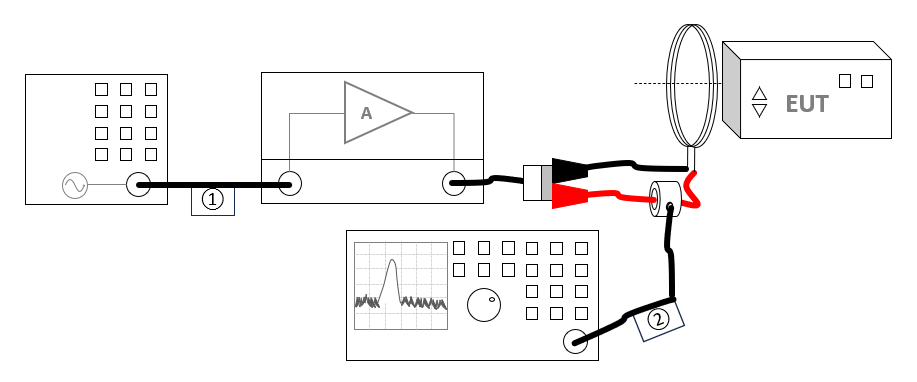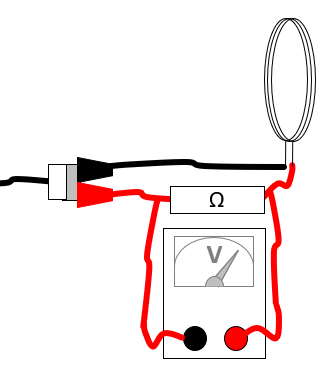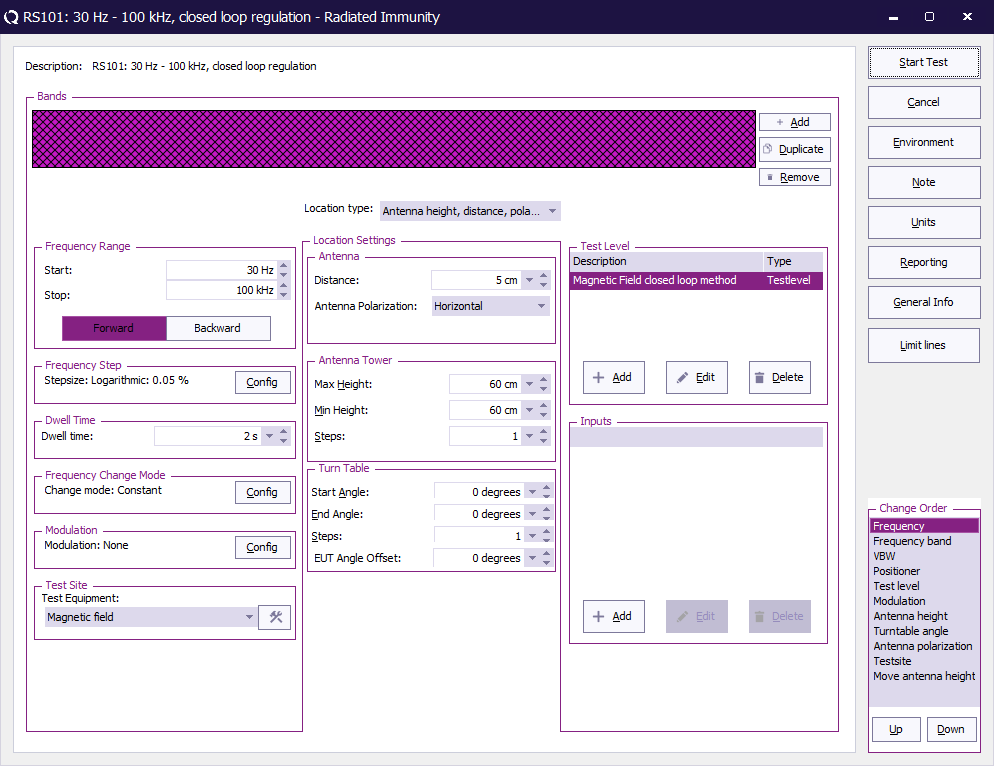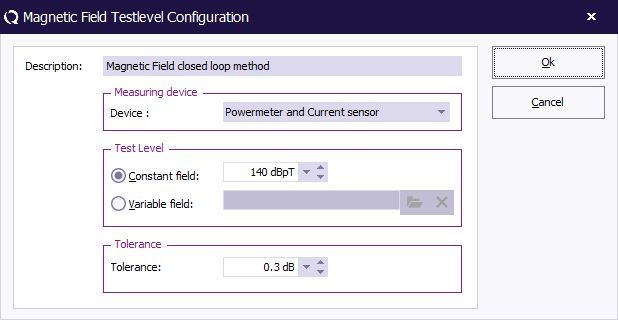RadiMation Application Note 140
How to perform a closed loop magnetic field test[edit]
This RadiMation® application note explains how a closed loop radiated immunity magnetic field test can be performed with RadiMation®.
A very similar test for the generation of magnetic field can also be done using a calibration in advance of the actual test. Application Note 138: "How to perform a magnetic field close proximity test" describes how that calibration and test can be performed.
The advantage of using the closed loop regulation as described in this application note, is that no calibration is needed.
Magnetic field tests[edit]
For the generation of the magnetic field, loop antennas are used, with the exact specifications of wire thickness and number of windings, as specified in the applicable standard. Several manufacturers are providing loop antennas based on these specifications.
The current flowing through the loop antenna is a one on one relation to the generated magnetic field. For the measurement of the current, different measurement methods are available that can be used in combination with RadiMation®. It can be measured using a shunt resistor, or a current sensor.
Necessary equipment[edit]
The following test and measurement devices are needed:
- Signal generator
- Amplifier
- Transmitting loop antenna (according the specifications of the applicable standard)
- Cables
The current flowing through the loop antenna can be measured by one of the following methods, and depending on the used method, those additional test and measurement devices are also needed:
- Current sensor and powermeter
- Resistor and multimeter
- Resistor and oscilloscope
Equipment configuration[edit]
The following equipment configuration can be used:
The configuration of the testsite should then contain the following devices:
| Device name | Tab in testsite configuration window | note |
|---|---|---|
| Signal Generator | Devices 1 | |
| Amplifier | Devices 1 | |
| Antenna | Devices 1 | A Magnetic Flux Density correction file should be attached to the used antenna device. See Magnetic Flux Density correction file in Chapter 14 |
| Current sensor | Devices 2 | A transfer impedance correction file should be attached to the used current sensor device. See Current sensor impedance correction in Chapter 14 |
| Sensor powermeter | Devices 2 |
Instead of using a current sensor and powermeter, it is also possible to use a shunt resistor and a multimeter, or use the oscilloscope instead of the multimeter
The configuration of the testsite should then contain the following devices:
| Device name | Tab in testsite configuration window | note |
|---|---|---|
| Signal Generator | Devices 1 | |
| Amplifier | Devices 1 | |
| Antenna | Devices 1 | A Magnetic Flux Density correction file should be attached to the used antenna device. See Magnetic Flux Density correction file in Chapter 14 |
| Resistor | Devices 1 | The actual resistor value should be specified in the advanced settings of the used resistor device. |
| Multimeter | Devices 1 | Only needed if a multimeter is used for the measurement of the voltage over the resistor |
| Oscilloscope | Devices 1 | Only needed if an oscilloscope is used for the measurement of the voltage over the resistor |
To convert between the desired magnetic field and the required current through the loop antenna, the conversion factor of the loop antenna has to be known. This requires that a Magnetic Flux Density correction file is selected as the second correction file in the device driver settings of the magnetic field generating loop antenna. The correction file should include a frequency column and a correction column, where the values in the correction column are expressed in 'pT/A'. (also see: Magnetic Flux Density correction file in Chapter 14 of the manual). In the MIL-STD-461, this correction value is specified as 9.5x10^7 pT/A.
EUT measurement[edit]
The magnetic field loop antenna should be positioned close to the EUT, with a specified distance. Also open an EUT file in RadiMation® to store the measurement results of the tests.
To perform the real closed loop magnetic field test, the Radiated Immunity Multiband test can be started by selecting from the menu:
-
 Tests
Tests
-
 Radiated Immunity
Radiated Immunity
-
 Multiband
Multiband
-
-
-
All the desired test parameters can be set in this configuration window:
| The start frequency of the test. For example 30 Hz. |
| The stop frequency of the test. For example 100 kHz. |
| The frequency step that should be used to increment the frequency. For example 0.05 %. |
| The dwell time that should be used at every frequency. For example 2 seconds. |
| The mode that should be used to change from one frequency to the next frequency. |
| The modulation that should be applied during the dwell time at each frequency. |
| The name of the testsite that should be used. This testsite should at least have all the required equipment. |
| The type of test that should be used. For a magnetic field test use Antenna height, distance, polarization and angle. |
| The used distance between the antenna and the EUT. For example 5 cm. |
| The polarisation of the antenna related to the EUT. For a loop antenna, just specify Horizontal. |
| The minimum, maximum and number of heights that should be moved with an automated antenna tower. |
| The start and end angle and how many angles should be measured with an automated turntable. |
| The configuration of the testlevels and limits that should be used during the regulation of the test. |
| The configuration of additional inputs that should be measured during the test. |
In the test configuration a Magnetic Field closed loop method testlevel can be added. In the Magnetic Field closed loop mthod testlevel configuration the requested testlevel can be specified. In this configuration dialog, also the levelling method can be selected, to specify which devices are used to measure the current that is flowing through the magnetic field generation loop.
| Specifies the name that should be used for this testlevel. |
| The device combination that is used for the measurement and regulation of the current, and thus also the magnetic field. This can be Multimeter and Resistor, Powermeter and Current sensor or Oscilloscope and Resistor. |
| The desired testlevel for the magnetic field. |
| A correction file that should be used to for a frequency depending testlevel, which allows to do variation of the magnetic field strength over the frequency. |
| The tolerance (specified in dB) that should be used for the accuracy of the regulated testlevel. For example: 0.3 dB. |
Depending on the applicable standard, the test level is often specified in dBpT, dBμA/m or A/m. The Units button can be used to change which unit should be used for the Magnetic Field to specify the Testlevel constant field.
When this test is started, the signal generator will be set to every frequency, and the current flowing through the transmitting loop antenna will be regulated to the current that correlates to the requested magnetic field. Once the EUT test is finished, the results of this test is stored in the EUT file, and available as one of the performed Tests in the EUT file. Selecting the corresponding test result and pressing on Info will show the test results again.
The magnetic field transmitting loop should be located close to the EUT itself. If the EUT is larger than the illumination area of the transmitting loop, the same magnetic field test has to be repeated for example for every 30cm x 30cm area of the EUT. Also all sides of the EUT have to be tested. This can be easily done by repositioning the loop antenna, and starting the same test in RadiMation® again.
Conclusion[edit]
The RadiMation® Radiated Immunity Multiband test can be used to regulate the current through a well known loop antenna. And because the relation between the current and the generated magnetic field is known, the desired magnetic field can be generated. This test can then be used to test if the EUT is not influenced by the generated magnetic field.



